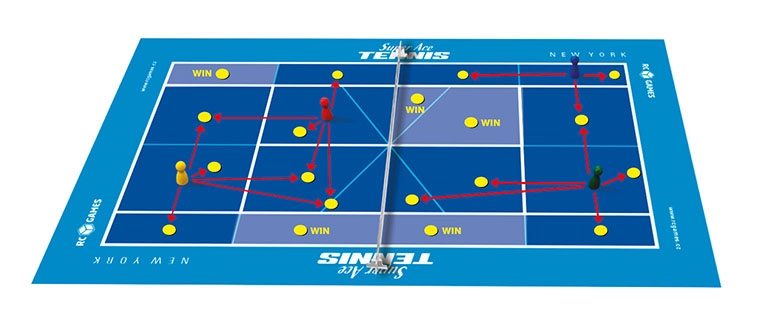Game rules
How do you play?
Exciting tennis matches don’t only have to be followed at tennis stadiums or on TV. Have a brief look at the rules and start playing. You will discover that immersing yourself in tennis battles has never been easier.
Preparation of the Playing Area
- Take the court out of the tube box and lay it out on a flat surface. Assemble the net using the net posts that fit in the grooves on both ends of the net, and place the it on the centre line of the court.
- The wooden pawns represent players; two are used for a singles match and four for a doubles match. The small yellow disc is the tennis ball.
- If you want to keep score with the help of the mobile application, download it into your smart phone or tablet using the provided QR code. Now you are ready to start playing.
Game Principles
- The game can be played by either two (singles match) or four players (doubles match). The aim of the game is to shoot and place the ball on the opponent’s half of the court so that they cannot reach it, or so that they have difficulties returning it. The player shoots the ball by pressing the edge of the wooden pawn against the edge of the small plastic disc representing the ball (same principle as in the Winks game).
- The playing area (court) is divided into two halves by the net, and each half is divided into ten sections. All lines have the same significance disregarding their width; the wider lines are there to show the layout of a real tennis court. The four larger rectangular boxes are used for singles matches, the four narrower sections on the sides extend the court for doubles matches. The two triangular fields at the net are only used for serves. A ball shot into this triangle is an ace; for rallies that follow the serve, the triangular sections are of no importance. The receiving player always returns the ball from the spot it landed in and then places his pawn anywhere inside the same box, so that his position is clear; the pawn must never stand on a line between the boxes. The only exception to this rule is the player on serve, who moves his pawn to the T after completing a successful serve.
- A player can access and return any ball that lands in his box or neighbouring boxes; however, if the ball lands in the box which is diagonal to the one he is standing in, it is out of his bounds.
- The match starts with a player serving, after that, players take turns in playing the ball so that it flies over the net and lands on the opponent’s side of the court. The rally continues until one player manages to make an unreturnable shot (“a winner”) or until a player makes a mistake by failing to hit the opponent’s side of the court (“an error”).
Score Keeping
- The scoring system is the same like in real tennis.
- A tennis match works in three phases: A game, a set and a match.
- A game is played until a player scores at least four points, but always two more than his opponent.
- A set is a collection of games, played until a player wins six or seven games.
- A match is played to a best-of-three or five sets. The decision how many sets you wish to play is up to you.
- The match begins with the first game; when a player wins the first point, the score is 15:0, if he wins another, it is 30:0, if he wins a third point it is 40:0 and adding a fourth point wins him the game. If the score in a game is equal at 40:40 (deuce), the next point is counted as “advantage” (AD) for the player who won it. If the same player gains another point, he wins the game, if he loses it, the score returns to deuce .
- In order to win a set, a player must win six games by at least two games (e.g. 6:4).
- If the score is tied at 6:6, a so called “tiebreak” game is played to speed up the match. The first player to win seven points, by two (e.g., 10:8), wins the tiebreak game and set with a score of 7:6.
- The aim of the game is to gain the required number of sets.
- There are four basic point generating situations in the game:
- Ace
- Double fault
- Winner
- Error
The SuperAce Tennis Game Application
The game app developed specially for this game allows players to enjoy their matches without having to remember the score or take notes. Score keeping is done by the app.
Step 1: Select NEW MATCH for starting a new game or LOAD for opening a saved game. Select a best-of-three or best-of-five set match, choose a singles or a doubles match.
Step 2: Select sides (red or blue), fill in the names (your own name, team name, name of a fa-mous tennis star etc.)
Step 3: Start the game by pressing NEW MATCH.
Step 4: Game: the racket and ball symbol indicates who is on serve the “R” or “L” beneath the racket symbol indicate the side of the court the server serves from (R is right, L is left) the stopwatch records the duration of the match.
An incorrect game record can be changed by pressing the arrow key and rewriting the entry. Each new entry is accompanied by a tennis ball hit sound effect. An ace is rewarded with ap-plause.
Game results can be recorded in two ways:
1. Using the white keys
WIN – a point scored by own well played ball
ERROR - a point scored by opponent after a fault
ACE – a point scored by serving an unreturnable ball
D. FAULT – a point scored by opponent after a server’s double fault
(The ACE and D. FAULT keys are automatically only available for the server).
2. By swiping the numbers beneath the Points column.
On serve:
Swiping across a number left to right = ACE (a point scored by serving an unreturnable ball)
Swiping in opposite direction right to left = D.FAULT (a point scored by opponent after a server’s double fault)
During rallies:
Swiping upwards across a number = WIN (a point scored by own well played ball)
Swiping downwards across a number = ERROR (a point scored by opponent after a fault)
A Singles Match
- The players toss a coin to decide who serves first. The player on serve places his pawn on the right half of the baseline and attempts to shoot the ball over the net diagonally into his opponent’s left half of court. The receiving player can stand anywhere in this area.
- The first serve of each game is always made from the right side of the court, the following serve is from the left, and sides alternate after each point.
- After the end of each game, the server and receiver switch roles.
- The server has two attempts to make a good serve. If both attempts fail, it’s a double fault and the receiver wins the point. A serve is unsuccessful if: the ball does not fly over the net, the ball lands in the server’s half of court, the ball lands and stays outside of the opponent’s designated service area or completely out of the court. If the served ball hits the net and lands in the designated area, the server repeats his serve without losing his second attempt.
- If the server manages to shoot his serve inside the triangular section just behind the net or the ball touches a line of the triangle, it is a winner, a so called “ace” which is out of the bounds of the receiver and the server wins the point.
- After completing his serve, the server advances from the baseline to the T, which gives him the significant advantage of being able to reach any ball his opponent manages to return into any part of the court.
- The ball is always returned from the spot where it stopped and remained lying.
- If a ball is shot into the box which is diagonal from the one where the receiver is standing, it is out of his reach; the shot is a winner for his opponent who gets the point.
- The ball is a winner even if after landing, most of its surface stays outside of the designated area or court but it partly touches the line. If in doubt, you can use your smart phone as the “hawk’s eye”. Take a bird’s eye view photo of the situation, zoom in to enlarge the picture. If there is a visible gap between the line and ball, the ball is out.
- If the ball lands in the box where the receiving player is standing or in one of the two neighbouring boxes, it is within the player’s reach and he returns it from the spot it stayed in. The player then must remain standing in the same box but can choose where exactly he positions himself as long as he does not touch a line between the boxes.
- If the ball lands on a line between boxes, the receiver returns the ball and can choose which of the boxes he wants to stand in for the next hit.
- Fault balls (errors) are: the ball does not fly over the net, the ball lands in the player’s own half of court, the ball lands and stays completely out of the court without touching a line. In these situations, the point goes to the opponent.
- A situation when the ball hits the opponent’s T gives the returning player the advantage of being able to stay there after returning the ball and being able to access a ball played into any part of the court (just like after serve).
- If a player hits his opponent’s pawn and the ball stays inside the court where the receiver can reach it, the game normally continues with a return from the landing spot. If however, the ball reflects from the pawn and flies out of the court or into a box which is out of the receiver’s bounds, it is the receiver’s fault and the point goes to the player who hit him.
- The game strategy can either be aggressive, that is attempting to hit the ball so that the opponent cannot reach it, or playing patient safe balls and waiting for the opponent’s mistake.
A Doubles Match
- The rules for doubles are the same as for singles, except the wider court is used and there are four players (pawns).
- The team that wins the draw starts serving. The two players decide who serves in the first game and then the serve rotates so that each player serves once every fourth game.
- The team on serve places the server on the right half of the baseline; the other team member can choose any box from which he wants to cover the court.
- After completing his serve, the server advances from the baseline to the T, which gives him the significant advantage of being able to reach any ball his opponent manages to return into any part of the court including the doubles alley (the narrow boxes between the singles and doubles sidelines).
- One of the opponent’s players stands in the left half of the court to expect the serve, which he then returns, the other player can choose to stand in any box from which he wants to cover the court.
- In the rally that follows, the players can decide who will play the ball if they can both reach it from the boxes they are standing in.
- If the ball can be reached by only one player, he is the one to return it, the other remains standing in his box and can only reposition himself within this box.
- A ball that cannot be reached by either player is a winner. Similarly to the singles match, this is a shot made into a box which lies diagonally from those where the other team’s players are standing. In the case of the doubles match, a ball is also out of bounds of a player if there is another box between him and the ball.
- For doubles, the key strategic task is to force the opponent’s server from his powerful position on the T that allows him to cover the whole area of his side of the court and return from any box.
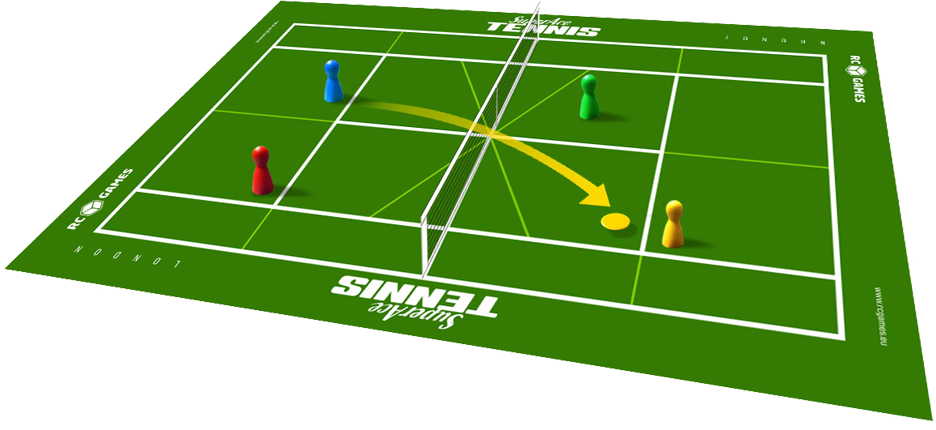
Game tactics
The tactics of the game, as in real tennis, may be an aggressive approach and an effort to always place the ball so that the opponent does not overtake it. But it requires training for precise strokes. A more careful tactic is a game in which the player returns the blows "for sure" and waits for the opponent's mistake. In the case of doubles, it is tactical to try to get the serving player from a convenient position on the center cross, from where he can control and overtake all the fields on the court. In doubles, as in real tennis, players do not have to take turns returning, the one for whom playing is more advantageous plays.
As in real tennis, it is necessary to train strokes, especially it pays to master the service and minimize double mistakes. The calculation of the score is facilitated by our own application Super Ace TENNIS, which we recommend to everyone for download.
Example of SuperAce TENNIS rules
Serve
The red player serves from the right half of the base line (ad court) over the net diagonally to the left half of the court. (The serve can land either in the front or back box.) The blue player can reach the balls indicated by red arrows; balls marked as ERROR are outs of the red player. Similarly to real tennis, the player on serve has two attempts. If both attempts fail, it is a double fault and the point goes to the receiver. If a serve is successful, the player moves to the T. The players alternate in serving after each completed game.
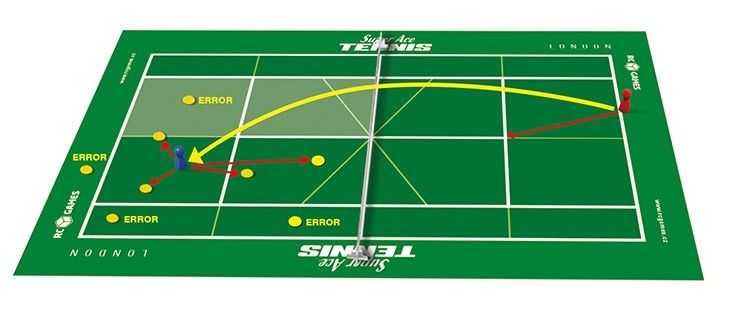
Ace
If the server manages to shoot his serve inside the triangular section just behind the net or the ball touches a line of the triangle, it is a winner, a so called “ace” which is out of the bounds of the receiver giving the server the point.
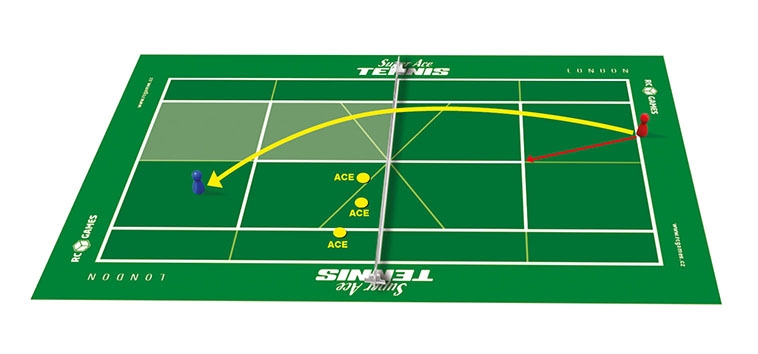
After the serve
After completing his serve, the server advances from the baseline to the T, which gives him the significant advantage of being able to reach any ball his opponent (blue player) manages to return inside any part of the court. The blue player returns the ball from the spot where it landed and remains standing anywhere inside the same section to await the return of the red player.
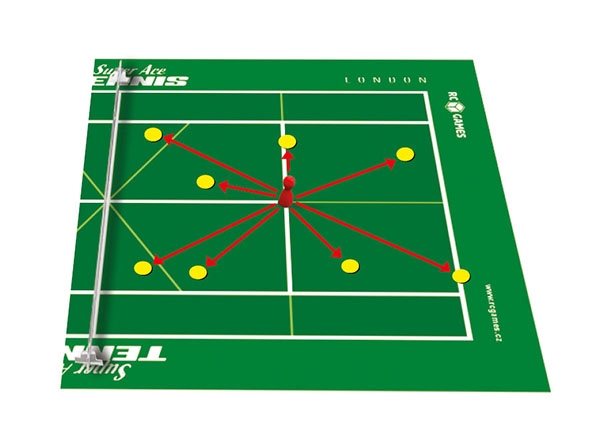
Singles match – game situation
A ball shot into the box which is diagonal from the one the receiver is standing in (greyish-green section), is out of his reach and is a winner for the opponent. The pawn is a part of the court, so if a ball hits it and lands in a box which is not diagonal, it is a good ball and is played from the place where it landed.
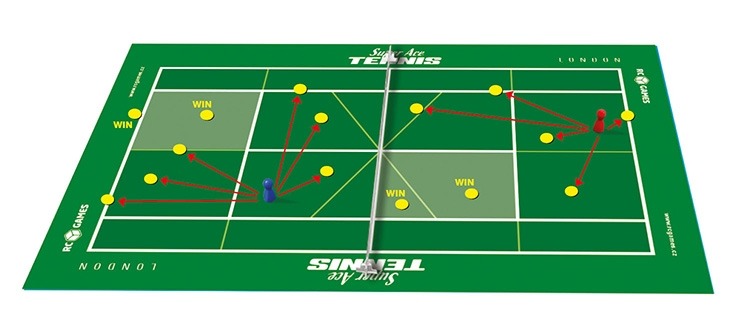
Doubles match – game situation
A winner is a ball that cannot be reached by either player of the opponent’s team. Similarly to the singles match, this is a shot made into a box which lies diagonally from those where the other team’s players are standing. In the case of a doubles match, a ball is also out of bounds of a player if there is another box between him and the ball. Red arrows indicate balls the players can reach.
